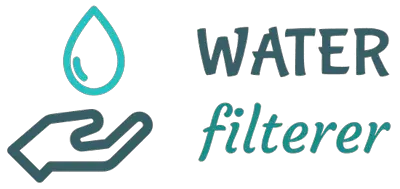Reverse osmosis is actually a very simple process. Water is forced through a semi-permeable membrane. The pores in the membrane are small enough to allow water molecules through but not molecules of salt or other contaminants. This process removes up to 98% of all impurities from the water, making it much healthier to drink.

One drawback of reverse osmosis systems is that they can waste up to 20 gallons of water for every gallon of clean drinking water they produce. However, this is still much less water than you would use if you were boiling your water to purify it.
Here’s a closer look at how reverse osmosis systems work and why they are not as wasteful as many people believe.
How Does a Reverse Osmosis System Work?
Reverse osmosis works by using pressure to force water through a semipermeable membrane. The pores in the membrane are small enough to allow water molecules through but not larger molecules like unhealthy contaminants.
As the water is forced through the membrane, the contaminants are left behind, leaving you with clean, healthy drinking water. The membrane is designed to let average sized molecules through while blocking others, which is why reverse osmosis can remove up to 98% of impurities and unhealthy contaminants from the water.
This makes it much healthier and safer to drink, as you are removing chemicals and other unhealthy substances that could be dangerous if consumed in high quantities
However, there is one drawback to reverse osmosis – they can use a lot of water in order to produce just a small amount of clean drinking water. For every gallon of clean water produced, the system can waste up to 20 gallons of water
The wastewater from reverse osmosis systems typically contains only 2-10% of the contaminants that were present in the original water supply. The rest of the contaminants are flushed out with the wastewater. However, because the wastewater still contains some contaminants, it must be properly disposed of so that it does not pollute freshwater supplies.
With new improvements in technology, they are becoming increasingly more efficient and less wasteful. Many communities also offer incentives for homeowners to install reverse osmosis systems or to make changes in their water usage habits, which can help offset the costs of installing a reverse osmosis system.
Are Reverse Osmosis Systems Wasteful?
Reverse osmosis systems are not nearly as wasteful as many people believe. A typical reverse osmosis system will use about 3-4 gallons of water to produce 1 gallon of purified water.
While this may seem like a lot of water, it is actually much less water than you would use to purify your drinking water using an alternative method. For example, if you were distilling your water to remove contaminants, you would need even more water to replace the water that was boiled away from the initial batch of water.
How to reduce waste water in RO system
A lot of reverse osmosis (RO) systems currently installed in homes today produce a lot of wastewater.
But there are a number of ways to reduce the amount of wastewater produced by your RO system.
Here are six ways to reduce waste water in your RO system:
- Slow down the flow rate. The slower the water flow rate, the less wastewater is produced.
- Increase the pressure. Higher pressure means less wastewater.
- Use a One-Way valve. A one-way valve prevents backflow, which means less wastewater overall.
- Install a smaller RO membrane. A smaller membrane will produce less wastewater
- Install an enhanced waste water recovery system. These systems are designed to recover most of the wastewater produced by your RO system.
- “Short Cycle” your reverse osmosis unit. If your home only has a small amount of wastewater produced overall, you can “short cycle” the system.
Slow Down the Flow Rate
The faster water flows through an RO system, the more wastewater is produced. That’s because when water flows quickly, it doesn’t have time to be completely filtered and some of it will be flushed away as waste before it has a chance to be completely purified. Slowing down the flow rate gives the water more time to be filtered and thus reduces the amount of wastewater produced.
Increase the Pressure
Another way to reduce wastewater is by increasing the pressure. This is because when water is under more pressure, it requires less time to pass through the RO membrane. As a result, less water is flushed away as waste, and more is purified and collected as treated water.
Use a One-Way Valve
A one-way valve prevents backflow, which means that less water overall is sent through the system multiple times and wasted in the process. By using a one-way valve, you can reduce your system’s overall wastewater output without sacrificing performance or quality.
Install a Smaller RO Membrane
One of the simplest and most effective ways to reduce wasted water in an RO system is to install a smaller membrane. When installed properly, a smaller membrane will still be able to produce the same amount of purified water as a larger one, but it will do so with less wastewater. This is because a smaller membrane has a higher efficiency rate, which means that it produces less wastewater for every gallon of purified water it produces. If you’re not sure what size membrane you need, our team of experts can help you select the right one for your needs.
Install an Enhanced Waste Water Recovery System
Another great way to reduce wastage in an RO system is to install an enhanced wastewater recovery system. These systems are designed to recover more of the wastewater that would otherwise be lost during the purification process so that it can be reused instead of being flushed down the drain. There are a number of different types of enhanced wastewater recovery systems available on the market, so again, our team can help you select the one that’s right for your needs.
“Short Cycle” Your Reverse Osmosis Unit
If you find that your RO system is producing more wastewater than you’d like, another option is to “short cycle” it. This simply means running your RO unit for a shorter period of time than usual so that it doesn’t have a chance to produce as much wastewater. Of course, this also means that you won’t be able to produce as much purified water, so this isn’t always a practical solution if you have high water demands. If you find that you only need a small amount of purified water and/or your RO unit is producing more wastewater than necessary, short cycling may be the perfect solution for reducing wastage.
Conclusion
Reverse osmosis systems are a great way to get clean, safe drinking water without having to boil it first. They are also very efficient, only wasting a small amount of water for every gallon of clean water they produce.
If you are concerned about the amount of water wasted by a reverse osmosis system, look for a model that comes with a tankless water heater so you can recycle the wastewater and put it to good use.

